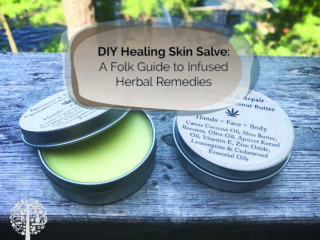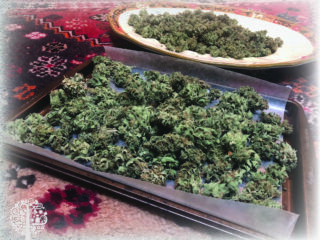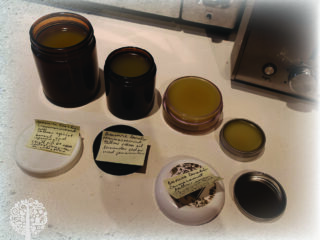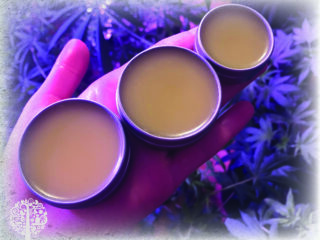My absolute favorite herbal remedy comes in the form of a topical!
The versatility of an herbal skin salve, akin to the variety of cooking, can be seasonal, vegan or animal-based, cannabinoid-infused or not, and used to support different systems. Here’s an overview of some of the creations I’ve been working on formulating for the past years.
As a disclaimer, I tend to think of myself as a “folk medicine” maker, which, to put it crudely, means I don’t measure much and won’t provide you with an exact recipe. I never create the same batch twice, and I’m constantly experimenting. Similarly, I don’t follow recipes in the kitchen (which is why I’m not a baker!).

Salves and Folk Medicine Foundations
The foundation of a salve consists primarily of a semi-solid oil base, along with some beeswax. The ratio depends on how soft or hard you want your salve to be! A general rule is one ounce of wax per cup of oil. Increasing the beeswax ratio creates firmer products, such as lip balm. You can also use liquid oils as a base, such as calendula-infused olive oil. However, I tend to use cannabis-infused coconut oil, in addition to other semi-solid fats, like tallow, lanolin, or lard.
Fun fact: the witches’ flying ointments of old were often made using the latter, infused with psychotropic and noxious plants. Think belladonna, aka deadly nightshade, henbane, and mandrake (Happy Spooky Season, Witches!).
Popular plant-based options for the base of a healing skin salve include shea butter, cacao butter, or mango butter. They can also be infused with herbs from the garden, such as lavender, comfrey, and arnica.
Practical Applications for DIY Salves
During the summer months, I sometimes add zinc oxide to the mix to create a mineral sunscreen. I’ve also made a solid hair gel with tallow, beeswax, bentonite clay, and essential oils.
Lately, I’ve been creating skin salves using the ingredients I have on hand (or in my garden).
Note that I do favor cannabis as my infused herb because fat-soluble cannabinoids are potentially wound-healing and anti-cancer, making the plant excellent for skin.
I transform aging cannabis flower into a deep, green coconut oil using a double boiler and a cheesecloth. I’ll then melt my beeswax, add my canna coconut oil, and/or (usually and) tallow (or a plant-based butter) as the second most abundant ingredient, followed by a mixture of other premium oils. Lastly, I round the whole thing off with essential oils.

Specialty Oils for Salves
Some secondary oils might include sweet almond, apricot kernel, jojoba, or lanolin. My tertiary oils are often the most expensive and are used in the smallest amount. They include rosehip, seabuckthorn, argan oil, and cranberry or pomegranate seed oil. Vitamin E oil can also be used now as a preservative.
Remember that high-heat oils should be melted first and then removed from the heat to incorporate more delicate or volatile oils.
Salves and Tips for Texture
If you dislike greasy moisturizers, try adding arrowroot powder or cornstarch to help absorb excess oil.
I’ve created a liquid moisturizer in the past using a cannabis-infused olive or walnut oil, along with liquid lanolin and other premium oils. Castor oil is another ingredient I sometimes add to my creations, whether liquid or solid, in small amounts.
When you’re near the end of crafting your blend, grab your mixing tool and spread a little on your hands. Too thin? Add a thicker agent, such as castor oil, coconut oil, or animal fat. Too much body? Add a lighter oil, like almond, jojoba, or vitamin E.
Vegetable glycerine is another option, but I feel like we can do better!

Salve Ingredients: Think Local, Think Seasonal
I love my coconut oil, but where are all the dang palm trees?
We’re at a loss when it comes to local vegan options in Canada’s cool climate. Canola, sunflower, soy, etc., are highly processed oils full of free radicals! You may have noticed that even high-end skincare product companies use sunflower oil in their formulations – likely because it’s a cheap filler.
I think I’m partial to infusing coconut oil since it’s an opaque, white substance that, when infused, turns dark green and solidifies into a gorgeous, light green. The same might be true of tallow, although I’ve yet to try it. It’s on my to-do list for the 2025 harvest.
So, in the same fashion as what you put in your body, when it comes to salves, balms, and butters, think locally! Try sourcing beeswax at the farmer’s market or a local artisan shop, tallow or lard from the butcher, and herbs you’ve grown yourself.

Aromatherapy and Salves
Once you’ve removed your double boiler from the heat and mixed in your specialty oils while still warm, it’s time for the finishing touches.
I won’t wax poetic about the joys and benefits of essential oils, but I will tell you my favorite combinations.
If I had to choose one single scent for my topicals, not a stack, my all-time favorite is lemongrass.
Though, IMHO, the best stacks are a mix of either woodsy with floral, or woodsy with citrus. But that’s because I love a musk. I love orange over patchouli, or geranium with cedarwood. The last batch I made was a blend of cedarwood, geranium, rosemary, and lavender.
In the winter, for me, nothing beats citrus. In the fall, anything spicy will do the trick. Tea tree is antiseptic, lavender is calming, and citrus is uplifting. And, of course, if you’re using weed oil, there will always be a hint of grass!
There you have it, my anti-listicle, DIY skin salve guide. Now, go ahead and try all your favorite formulas and aromas!